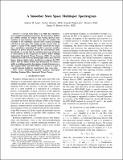A Smoother State Space Multitaper Spectrogram
Author(s)
Song, Andrew H.; Chakravarty, Sourish; Brown, Emery Neal
DownloadSongChakravarty_2018_EMBC18_1425_FI.pdf (1.272Mb)
Terms of use
Metadata
Show full item recordAbstract
A recent work (Kim et al. 2018) has reported a novel statistical modeling framework, the State-Space Multitaper (SSMT) method, to estimate time-varying spectral representation of non-stationary time series data. It combines the strengths of the multitaper spectral (MT) analysis paradigm with that of state-space (SS) models. In this current work, we explore a variant of the original SSMT framework by imposing a smoothness promoting SS model to generate smoother estimates of power spectral densities for non-stationary data. Specifically, we assume that the continuous processes giving rise to observations in the frequencies of interest follow multiple independent Integrated Wiener Processes (IWP). We use both synthetic data and electroencephalography (EEG) data collected from a human subject under anesthesia to compare the IWP-SSMT with the SSMT method and demonstrate the former's utility in yielding smoother descriptions of underlying processes. The original SSMT and IWP-SSMT can co-exist as a part of a model selection toolkit for nonstationary time series data.
Date issued
2018-10Department
Massachusetts Institute of Technology. Department of Electrical Engineering and Computer Science; Picower Institute for Learning and Memory; Massachusetts Institute of Technology. Department of Brain and Cognitive Sciences; Massachusetts Institute of Technology. Institute for Medical Engineering & ScienceJournal
40th Annual International Conference of the IEEE Engineering in Medicine and Biology Society (EMBC)
Publisher
Institute of Electrical and Electronics Engineers (IEEE)
Citation
Song, Andrew H. et al. "A Smoother State Space Multitaper Spectrogram." 40th Annual International Conference of the IEEE Engineering in Medicine and Biology Society (EMBC), July 2018, Honolulu, Hawaii, USA, Institute of Electrical and Electronics Engineers (IEEE), October 2018. © 2018 IEEE
Version: Author's final manuscript
ISBN
9781538636466
ISSN
1558-4615